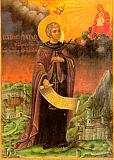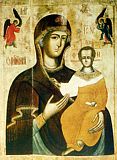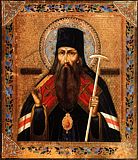

| Previous day | Next day |
| Old Style
July 28
|
Thursday |
New Style
August 10
|
| 10th Week after Pentecost. Tone 8. | No fast.
|
![]() Icon of the Most Holy Theotokos “Of Smolensk” (1047).
Icon of the Most Holy Theotokos “Of Smolensk” (1047). ![]() Holy Apostles of the Seventy and Deacons: Prochorus, Nicanor, Timon, and Parmenas (1st c.).
Holy Apostles of the Seventy and Deacons: Prochorus, Nicanor, Timon, and Parmenas (1st c.). ![]() St. Pitirim, bishop of Tambov (1698).
St. Pitirim, bishop of Tambov (1698). ![]() Synaxis of the Saints of Tambov.
Synaxis of the Saints of Tambov.
Martyr Julian of Dalmatia (ca. 138-161). Martyr Eustathius the Soldier, of Ancyra (ca. 316). Martyr Acacius of Apamea (ca. 321). St. Paul of Xeropotamou, Mt. Athos (996). St. Moses, wonderworker, of the Kiev Caves (13th c.-14th c.). St. Anthony, bishop of Rostov, Yaroslavl, and Belozersk (1336). St. Joseph, founder of Holy Trinity-Kozlov Monastery (Michurinsk) (1660-1661). St. Daria, abbess, of Sezenovo (1858).
New Hieromartyr Basil (Erekaev), hieromonk of Sarov Monastery (1937).
Icon of the Most Holy Theotokos “Umileniye” (“Of Tender Feeling”) of Diveyevo, before which St. Seraphim reposed (1885). Icons of the Most Holy Theotokos “Of the Lavra in Suprasl” (Poland) (16th c) and “Seven Lakes” (17th c.).
Sts. Ursus and Leobatius (Leubais), abbots, of Gaul (ca. 500). St. Samson, bishop of Dol, in Brittany (ca. 565). St. Irene Chrysovolantou of Cappadocia (912). St. George the Builder, of Iveron, Mt. Athos (1029). New Martyr David of Aleppo (1660). New Hieromartyr Ignatius of Jablechna (Chelm and Podlasie, Poland) (1942).
Thoughts for Each Day of the Year
According to the Daily Church Readings from the Word of God
By St. Theophan the Recluse

Thursday. [II Cor. 1:1-7; Matt. 21:43-46]
The chief priests and Pharisees perceived that the Lord was telling parables on their account, that He was opening their eyes so that they would see the truth. But what did they do with this? They thought about how to kill the Lord. If their common sense had not been distorted by their prejudice, then even if they could not believe, as the obviousness of the instruction required, they should at least have thought over carefully whether what the Savior was saying is true. Their prejudice pushed them onto a crooked path, and they then proved to be God-killers. It always has been this way, and it is this way now. The Germans, and our people who have followed after them and become Germanized in their thought, immediately cry out whenever they come across a miracle in the Gospels, “Not true, not true; this didn’t happen and couldn’t happen, this needs to be crossed out.” Is not this the same as killing? Look through all the books of these clever men; in none of them will you find any indication as to why they think this way. Not one of them can say anything against what the Gospel truth proves, and not one cares to comprehend the arguments which soberminded people use to convict their falseness; they only continue insisting that [what is written] could not be, and that is why they do not believe the Gospels. And you cannot do anything with them—they are ready to go against God Himself.
Articles
 St. Pitirim the Bishop of TambovSaint Pitirim, Bishop of Tambov, in the world Procopius, was born 27 February 1645 (or 1644) in the city of Vyazma. |







